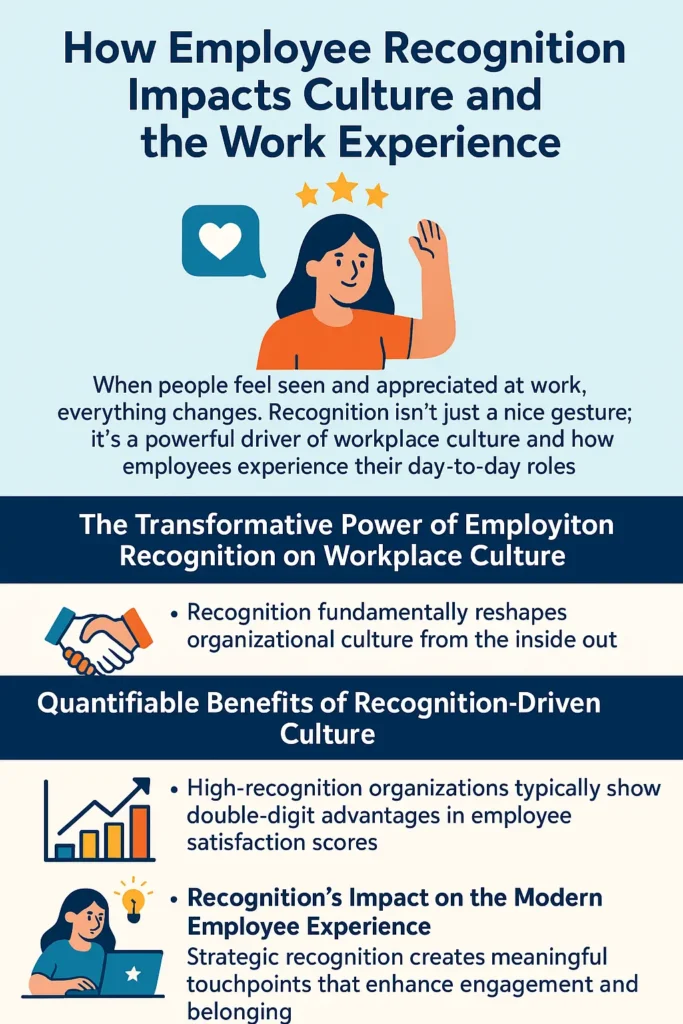When people feel seen and appreciated at work, everything changes. Recognition isn’t just a nice gesture; it’s a powerful driver of workplace culture and how employees experience their day-to-day roles. A simple thank-you or shout-out can boost morale, strengthen connections, and inspire better performance.
In today’s fast-paced work environment, where burnout and disconnection are real concerns, employee recognition stands out as a key ingredient for a healthier, more motivated team. In this blog, we will explore how recognition shapes company culture, improves the work experience, and creates a stronger sense of belonging across every level of an organization.
The Transformative Power of Employee Recognition on Workplace Culture
Recognition does more than make employees feel good. It fundamentally reshapes organizational culture from the inside out. When properly implemented, recognition initiatives become the invisible threads that connect your company values to everyday behaviors.
It also influences how teams interact and how individuals feel about their role in the bigger picture. Some organizations build recognition strategies around meaningful moments. Tools ranging from electronic birthday cards to peer-to-peer acknowledgments help celebrate employees and create lasting impressions that strengthen team morale.
Quantifiable Benefits of Recognition-Driven Culture
The most striking difference appears when comparing high-recognition organizations to those where appreciation is an afterthought. High-recognition companies typically show double-digit advantages in employee satisfaction scores, substantially lower absenteeism, and markedly higher customer satisfaction ratings proving that internal culture directly impacts external performance.
Recognition as a Culture-Building Cornerstone
Recognition works as a powerful reinforcement mechanism for your core values. When you acknowledge behaviors that exemplify your company’s mission, you’re effectively showing everyone “This is what success looks like here.” This psychological reinforcement helps employees internalize values rather than just memorizing them.
Recognition’s Impact on the Modern Employee Experience
Recognition doesn’t just influence organizational culture; it fundamentally transforms how employees experience work daily. From onboarding to retirement, strategic recognition creates meaningful touchpoints that enhance engagement and belonging.
The Employee Experience Lifecycle and Recognition Touchpoints
The most effective recognition happens at critical moments throughout an employee’s journey. New hires who receive recognition within their first week report 29% higher engagement in their first month. Similarly, acknowledging work anniversaries significantly boosts retention rates, with employee appreciation programs showing particular effectiveness at traditionally high turnover milestones.
Smart organizations map their recognition strategy across the employee lifecycle, identifying key moments when appreciation delivers maximum impact. These include project completions, skill development milestones, and personal achievements like work anniversaries or educational accomplishments.
Work Experience Enhancement Through Personalized Recognition
Personalized recognition directly activates the brain’s reward centers, releasing dopamine and creating positive associations with work. When recognition aligns with an employee’s personality and preferences, its motivational impact multiplies significantly.
Different employees respond to different forms of recognition. While some thrive on public acknowledgment, others prefer private appreciation. Modern recognition programs incorporate tools like electronic birthday cards and personalized achievement acknowledgments to ensure each employee receives recognition in ways meaningful to them.
implementing strategies like sending gifts to employees provides a memorable and personal touch that resonates long after praise is spoken. Whether for key milestones, project completions, or simply to show appreciation, curated gifts tailored to each employee’s preferences can significantly elevate morale and reinforce their sense of belonging within the organization.
Strategic Implementation of Recognition Programs That Drive Results
Creating effective recognition initiatives requires thoughtful design and consistent execution. The most successful programs balance structure with spontaneity to create a culture where appreciation feels both systematic and sincere.
Building a Multi-Dimensional Recognition Framework
Effective recognition operates across multiple dimensions, balancing formal and informal approaches while empowering employees at all levels to participate. Data shows that 52.5% of employees want more recognition from their immediate manager, highlighting the crucial role of leadership in recognition delivery.
Workplace culture thrives when recognition flows in all directions, not just top-down, but also peer-to-peer and even bottom-up. Companies like Google have found that peer recognition programs generate 36% more engagement than manager-only systems, as employees often notice contributions that leadership might miss.
Technology-Enabled Recognition Innovations
Digital platforms have revolutionized how organizations deliver recognition, making appreciation more immediate, visible, and inclusive. AI-powered systems can now identify recognition-worthy moments through behavior pattern analysis, while gamification elements add excitement to appreciation programs.
For distributed teams, digital recognition tools like virtual celebration platforms create connections despite physical distance. These technologies ensure that work experience enhancement reaches every employee, regardless of location or work arrangement.
Moving beyond implementation, let’s consider how organizations can measure recognition’s impact on business outcomes.
Measuring the Business Impact of Employee Appreciation
Recognition makes employees feel good, but it also delivers tangible business results that justify continued investment. Smart organizations track recognition’s influence on key performance indicators to optimize their programs.
Key Performance Indicators of Successful Recognition Programs
When companies spend 1% or more of payroll on employee recognition, 85% notice a positive impact on engagement. This remarkable ROI makes recognition one of the most cost-effective cultural interventions available to leaders today.
Beyond engagement, recognition directly impacts financial performance through reduced turnover costs, decreased absenteeism, and improved productivity. Companies with sophisticated recognition programs report 22% higher profitability than those without, translating recognition from a “nice to have” to a business necessity.
Advanced Recognition Analytics
Forward-thinking organizations leverage data science to optimize their recognition programs. Predictive analytics can identify which recognition approaches resonate most with different employee segments, enabling hyper-personalized appreciation strategies.
Sentiment analysis tools now evaluate the emotional impact of recognition messages, helping leaders understand which forms of appreciation generate the strongest positive responses. This data-driven approach ensures the impact of recognition programs continues evolving to meet changing employee expectations.
Developing Your Recognition Strategy
Employee recognition has an incredibly powerful effect on both workplace culture, as well as the employee experience. Organizations that effectively leverage recognition as part of their strategy experience higher employee engagement, lower turnover, and overall better outcomes for the business than organizations that disregard this essential aspect of the workplace.
Recognition isn’t about sporadically doing something extravagant; it’s about engaging in continual forms of meaningful recognition based on your values. Whatever stage you’re at in recognizing employees, either starting a recognition program or enhancing an existing program, you should look for opportunities to create authentic moments of appreciation that fit with your team.

FAQs
- How Does Recognition Enhance the Employee Experience?
Recognition indicates to employees that their contributions have value. This fosters a feeling of belonging and purpose for employees. Recognition creates a greater degree of psychological safety – an often challenging state for employees in the face of organizational change – because recognition tells members of the organization that their work has value.
- Why Should Leaders Focus on Employee Recognition?
Workplace recognition increases engagement and productivity, and increases employee loyalty and retention, which reduces turnover costs. However, there are many other benefits to employee recognition beyond the quantifiable benefits of employee recognition.
- What Results Should We Expect From a Recognition-Focused Workplace Culture?
When a workplace culture is recognition-focused, the culture will produce higher employee engagement and satisfaction. It will foster cohesiveness in teams. It will most likely result in better business results. When recognition is embedded in the everyday behaviors of employees, recognition becomes a self-reinforcing cycle of good behaviors.
Also Read-116+ Pizza Pick Up Lines That Work 🍕💘










